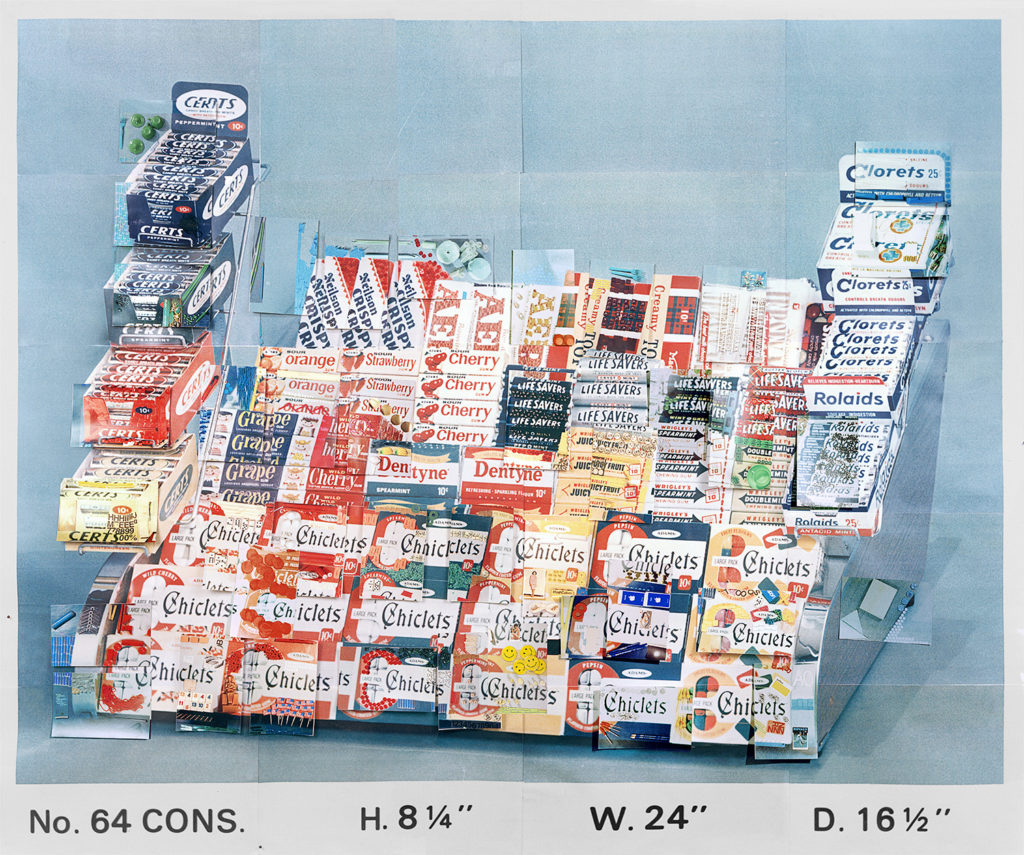
Display Stand No. 64 CONS H. 8 1/4″ W. 24″ D. 16 1/2″, 2014. Chromogenic print mounted on Plexiglas, 30 x 36 in. (76.2 x 91.4 cm.) Edition of 3 with 2 AP
Introduction
What’s to make of our bubbly, pitiless love of things? Our pots and pans, Air Pods, and custom Nike’s; who’s to save our faded art and images of lipsticked celebrities from colliding into each other or collecting dust in the Cloud? Artist Sara Cwynar’s interest in the optimistic-turn-delipidated lifecycle of an object, parallel to its image began with her first project, Kitsch Encyclopedia (Blonde Art Books, 2014). The book was produced in 2010 during her senior year of college and exhibits odes to the labor of design. As it seems to surface in Kitsch Encyclopedia, Cywnar’s investigation of theory and image-world also exhibits itself, challenging the categorizing phenomena of kitsch as “a means through which complex human experience is distilled to simple, sentimental motifs” (Kundera). As a photographer and video artist based in Brooklyn, New York, Cwynar work recodes and reanimates the theory, images, and objects that were once loved and now faded.
I spoke with Sara over the phone and via email during Fall 2020 to discuss her career arc and get to know the ins and outs of her practice.
Marie-Isabella Rogers: I wanted to start by talking about your early career and trajectory. I was pretty drawn to your work because it seems you’re so involved with academia; there’s a lot of literature and gusto behind your work.
I’m curious what your experience in school was like? Do you consider yourself, and your work, to be academic?
Sara Cwynar: Well, I went to English Literature school first, so I got a little bit of that education, and I’m really glad I did because then I went to design school and it was pretty limiting — it was very applied.
I gave myself a design-slash-theory education on the side of school by taking lots of courses outside of my department. I always felt like there was something really special about the combination of that dry and sometimes purposefully inaccessible language of critical theory and philosophy, mixed with accessible imagery; that’s something I wanted to combine from the very early days of my design education. I’ve always loved theory. I’ve always found it so satisfying to read. I felt like an imposter in the world of theory for most of my career, but then at some point I realized that no one really knows what they’re talking about, [Marie: laughs] even the people who write it.
I also didn’t think this at the time, but I can see it now, that theory distills some messy, chaotic world into something that’s digestible and easy to understand, and it tells what you want to know but in already concise terms. And design comes from the same impulse; it comes from taking a mess of information and repackaging it for someone else to understand more quickly. So, I think there was a real connection to organizing and re-presenting and reanimating stuff in my interest in design and in making art. I guess part of my project is also translating or making more digestible that kind of material, too. I also like misusing theory, and make it mean whatever I want it to mean.

Women, 2015. Archival pigment print mounted to Plexiglas, 32 × 25 in. (81.28 × 63.50 cm.,) Edition of 3 with 2 AP
MIR: What was your experience as a self-taught photographer, as I’ve heard you define yourself before? Do you think your independence from traditional methods of schooling, at least in your earlier approach to photography, allowed for more freedom in your decided misuse of theory?
SC: I started as a design major but I really just wanted to be an artist. Or, like maybe an English major or something. So everything that I’ve done — filmmaking, photography, and writing for the degree of writing that I do for myself — I’ve taught myself. I think there’s more freedom in approaching it that way and to do what art is best at, which is taking tools, taking technologies, and misusing them in ways that aren’t meant to be used and to let us see them and the content differently. I think being self-taught gives me a lot of freedom. I always get frustrated when I can’t get something to look at how a more skilled photographer makes it look, but in the end I slowly realized that it would probably make it more boring, anyway.
I think what’s accidentally appealing about my work is that you can see the human hand in it and you can see that it’s not quite the same as the public or the popular version of photography. it looks like advertising but it doesn’t quite look right. And that’s not always intentional, but I’ve learned how to work with that and use it in service of the points I’m trying to make.
MIR: How do you think that your approach changed after going to Yale, or even working at The New York Times?
SC: At Yale, I had to fight pretty hard to keep my approach. I didn’t want to let it change me that much. Yale helped me make every idea I had previously had in my brain and really figure out which ones worked and which one’s didn’t. I came out with a more solidified palette, even though it’s a little corny to use that word [laughs]. I had found a voice actor I continued to work with; I found a way of making video that worked for me. I found all these extra tools that I could use to mix together and to make different outcomes in my work, whether that was in photography or video, or in making a book.
This was also a product of working like a total lunatic for a decade. I worked so hard when I was at The New York Times, and being an artist on the side. I was 25 – 28-years old when I worked there and I had so much energy and ambition. I would wake up at 5AM and work for hours before I went to work. I used every vacation to do art and I always wanted to do bigger shoots; I just never stopped working. Then, I went to grad school, which was an insane amount of work. I think working at that insane pace, more so than any kind of specific ideology of the Yale Art School, or anything particular I learned at the time, helped me to hone in on making things that worked for me.
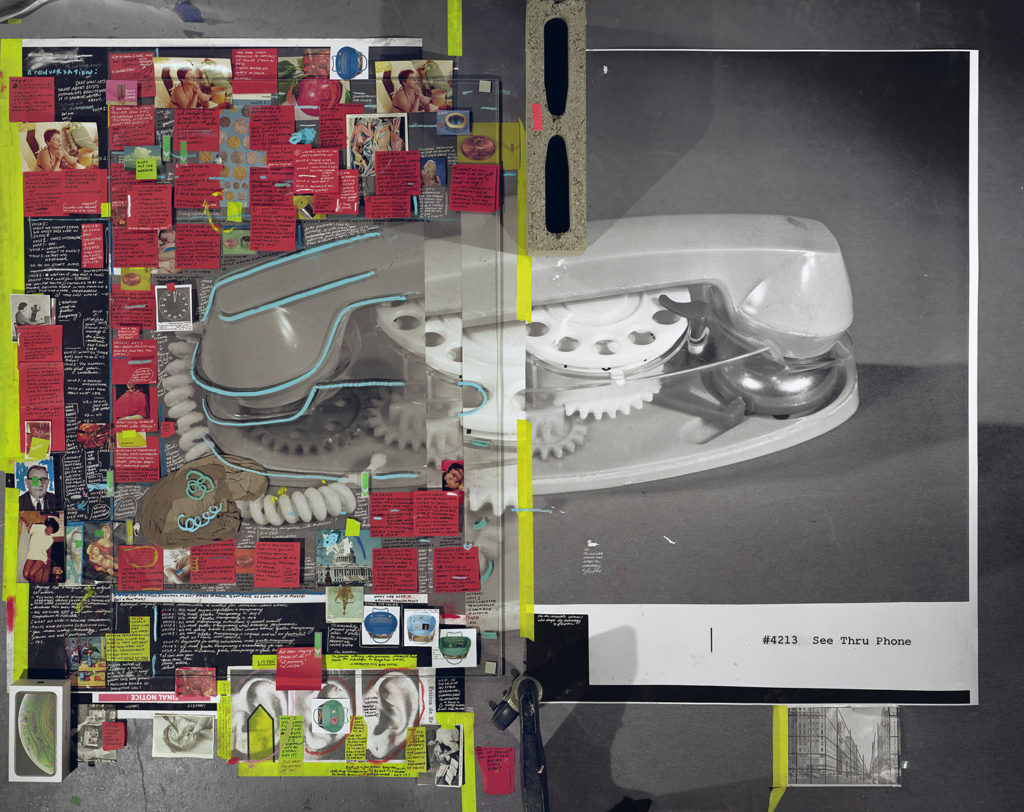
See Thru Phone (Photographed by Graphics Studio Milwaukee), 2019. Chromogenic print mounted to aluminum, 43 x 54 in. (109.22 x 137.16 cm) Edition of 3 with 2 AP
MIR: You’re beginning to work more with installation and in a digital workspace, is that right? Could you share more about the reasoning for this shift, and how it’s going so far?
SC: Yes – I think most artists have a fear of copying themselves, and that is one of the simple reasons. I think it’s important to switch up the parameters you fall into working within every once in a while – using different cameras and lenses, making rules about which materials are off-limits, and trying out different subject matter. I like to try to get far away from what I normally do and then somehow it always ends up being within my sensibility in the end anyway.
I also feel that in this time of uncertainty and this time where it is very difficult to grasp what is true or real within our media world, there is more potential in installation and video to reflect this world or to comment on it in a way that feels genuine. So that is a lot of my interest in making more installation-based work too. It feels truer to our time somehow.
After COVID — and maybe this is related to my desire to use fewer objects — I organized and scanned 500 of the photos I have in my studio, and now I have this digital archive I’m working with. I’m recombining them in InDesign and making big 40 x 60 ft wall installations. I like working with them in a digital space because it helps me see them in a different way, which has been cool.
MIR: What does your archive and studio look like these days? On a scale of Library of Congress to Francis Bacon, where are you on that spectrum?
SC: Well, actually, I just moved into a new studio before COVID. And literally the last day, when it was becoming clear that everything was falling apart, I had movers scheduled. It was really intense.
Now I have a really big studio; it’s 1200 sq feet and I build it out; I put photos up everywhere. And it feels tidy, because I haven’t made anything off the computer in here yet, but that will all change [laughs].
I had a really big studio when I was in grad school, too, and it really changed my work. I was able to start making video because I had all this space and I could kind of shoot multiple sets at once and could always just set something up and think about it for a while before I had to take it down, and that was really freeing. I have a pretty organized studio right now, but that’s not normal for me [laughs]. I like to live in chaos and then like whatever I happen to find goes into the photo. I think it’s pretty much working for me to be very unorganized, but I also don’t know how to be any other way.
Before I moved here I was in a 300 sqft studio that was basically me sitting in a storage unit [laughs] it was so full of stuff. There were just boxes and boxes of photos piled to the ceiling. So for the first time it feels like I have some space to move — which I think will really change my work. I’m thinking more about making larger installations.
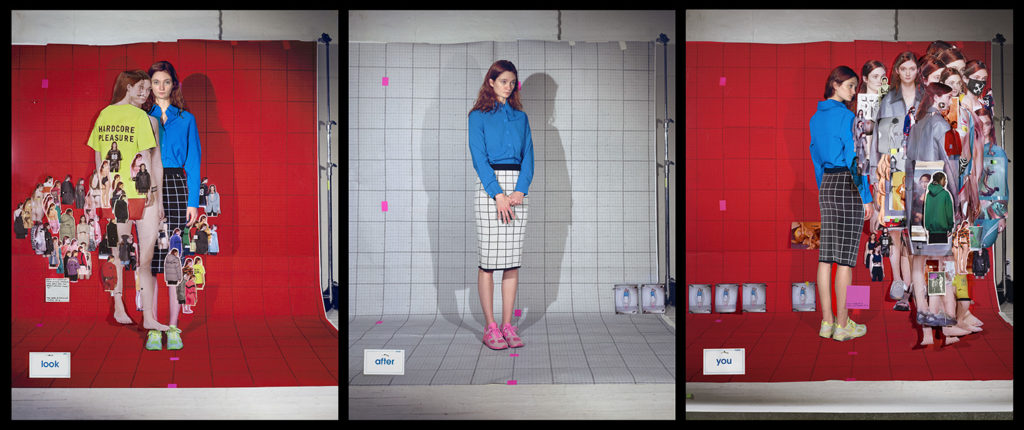
96 Pictures of Sophie 1, 2 and 3, 2019. Archival pigment print mounted to Dibond, 120.7 x 286.8 cm. Edition of 3 with 2 AP
MIR: Do you have an object relating to your practice that you have a special affinity for right now?
SC: I’ve been trying to use fewer props as a kind of challenge to myself, so right now I’m obsessed with this set of pictures I have of this women’s wrestling league in Los Angeles from the 80s. The pictures are these really beautiful snapshots, and they’re all numbered, and they have these women in various crazy, wrestling positions. But they also wrestled in bikinis and their boyfriends were their agents; a classic, problematic forced dynamic, which we see a lot. They look pretty sexualized, but when I researched this wrestling league, I think it was empowering for the women who participated. They were really invested in winning and they were all really good at wrestling. I love these pictures, and I’ve been putting one or two in a bunch of photos for a couple years and buying more and more on Ebay. I’m trying to make a video out of them, but I haven’t figured that out yet.
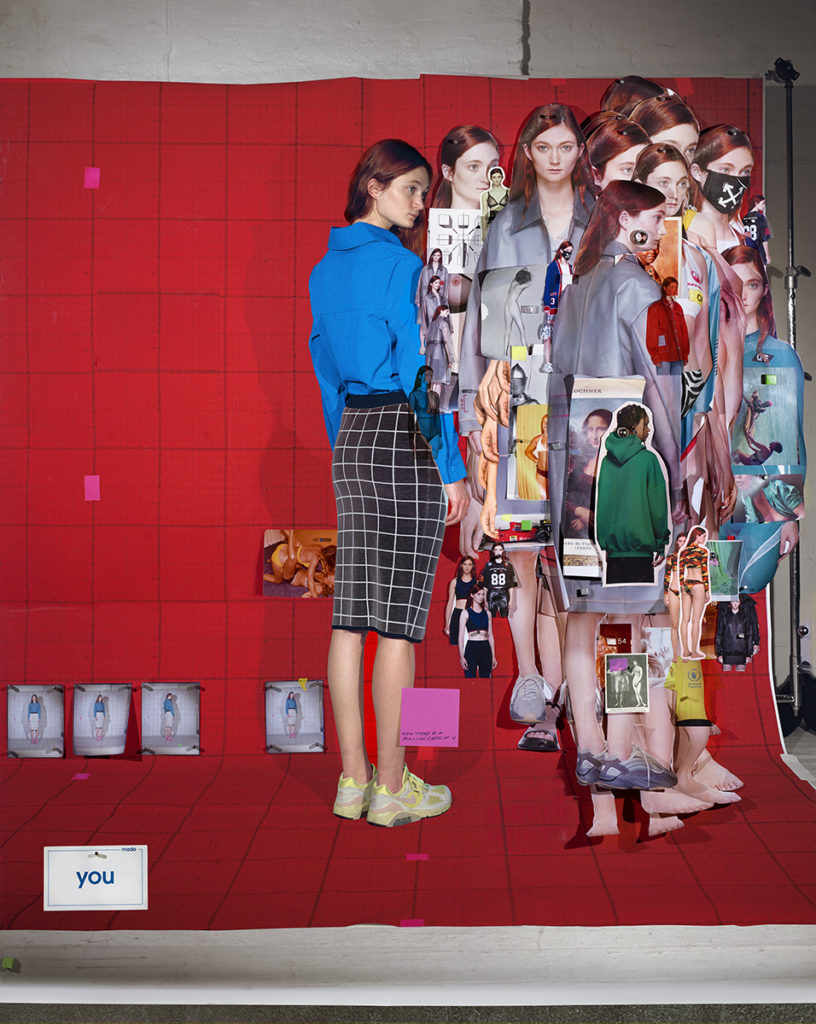
Detail from 96 Pictures of Sophie 1, 2 and 3, 2019. Archival pigment print mounted to Dibond, 120.7 x 286.8 cm. Edition of 3 with 2 AP
MIR: You started out with a more analog search method — rifling through junk drawers, going to 99 Cents Stores and the New York Public Library Archives. Are you mainly online shopping now? How does that frame your relationship with the props and objects that you buy?
SC: Before COVID, I bought a lot of stuff on Ebay. Ebay is almost a good analog to shopping in real life because you have the same experience of coming across something you weren’t looking for, then finding something way better.
I would also go into a lot of stores and flea markets — there’s really nothing as good as that for my purposes. But it’s also a good challenge to not rely on the inherent aesthetic satisfaction of old stuff. A lot of the stuff I have looks good, no matter what you do with it, and I’m just trying as a personal challenge right now to work in a different way.
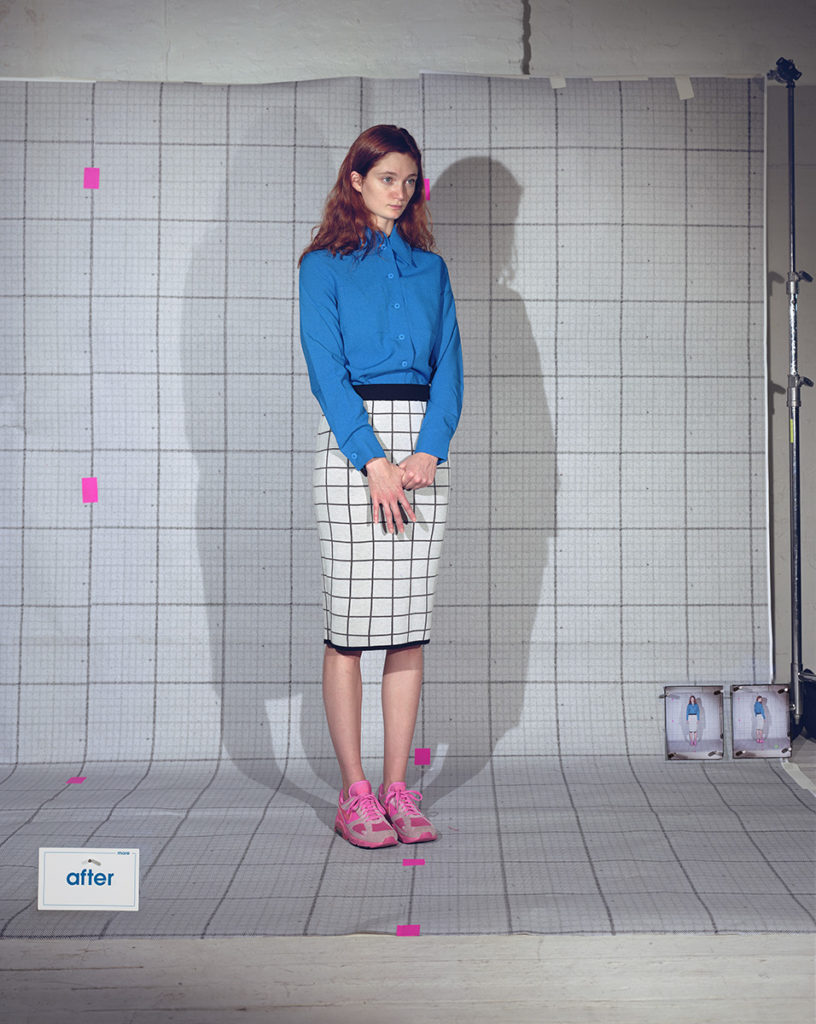
Detail from 96 Pictures of Sophie 1, 2 and 3, 2019. Archival pigment print mounted to Dibond, 120.7 x 286.8 cm. Edition of 3 with 2 AP
MIR: Have there been any weird oops moments when you were buying objects on Ebay? Like someone’s old breakup playlist still on their iPod, unwashed clothes, personal letters? What about personal traces of human touch, during your process of researching and acquiring the props, is appealing to you?
SC: This was something that was central to the Rose Gold (2017) film — the idea of buying something that’s a loved, shiny object that’s marketed to us as something that’s very optimistic, that then fades over time and becomes something that nobody wants anymore. There’s so much about the notions of progress and the founding tenets of western democracy in how objects are kept, sold or discarded — the way that progress doesn’t usually work out in the way that it was supposed to. It’s kind of the same thing as the mistakes in my photos, making them more interesting because they didn’t turn out how they were supposed to. The fact that things have been used and loved and touched by people points to how value gets created and constructed.
And so things end up being around after they are no longer desirable, and the relics of them are still all around us, and yet it doesn’t really fade our belief in that system — I mean, mine included, I’m still a sucker for a rose gold iPhone. I just got a new iPhone [laughs]!
But, there are tons of exceptions to this and every person is looking in different ways at every moment. It’s not a universal thing — we see with a collective eye and we see through a lens that’s been handed down to us.
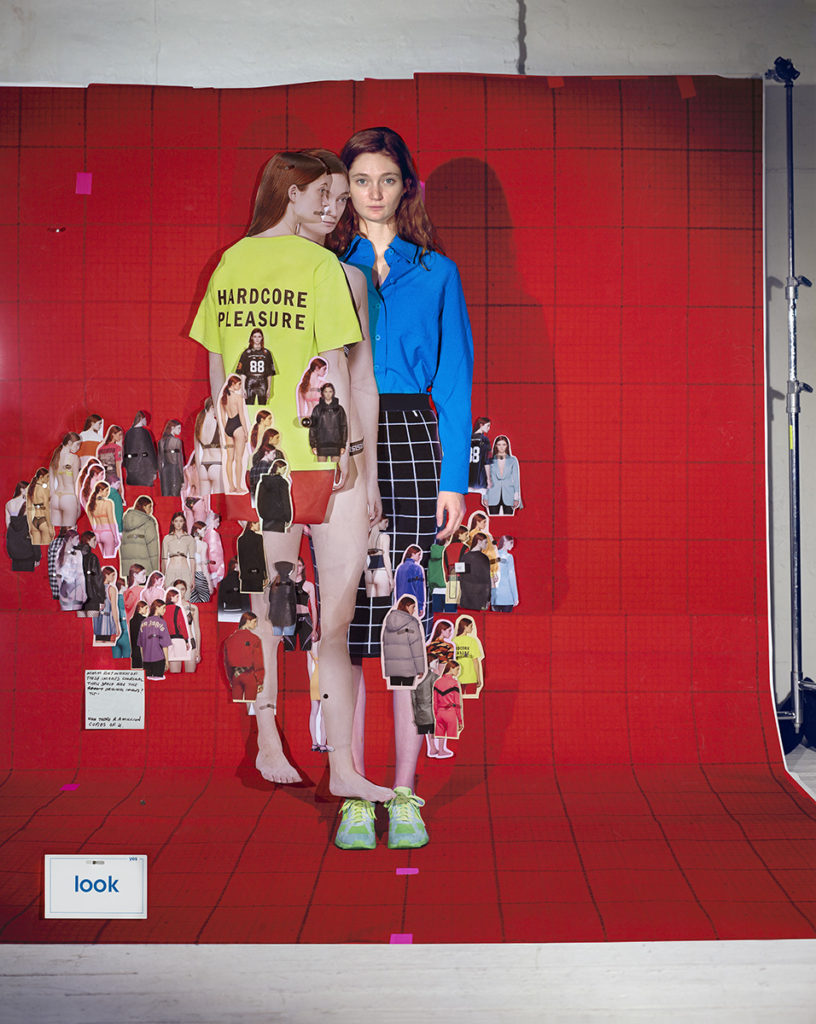
Detail from 96 Pictures of Sophie 1, 2 and 3, 2019. Archival pigment print mounted to Dibond, 120.7 x 286.8 cm. Edition of 3 with 2 AP
MIR: What about personalization is political to you?
SC: Like adding a personal note into a maybe public set of images?
MIR: Yeah, I suppose I’m asking about the process of reorganizing and reanimating someone else’s personal pictures, like in the case with the women wrestlers. What is it like to feel as though you have an audience, too, when you’re dealing with such big, pop-culture references, especially for the work in your recent show, Marilyn at The Approach?
SC: I do think that people are more drawn to stories — I think this is a Hilton Als idea — that we’re more drawn to stories than anecdotes. I don’t think there’s much use in repeating theory for 13 minutes, which is how long Red Film is, and you’re just going to lose your audience. There needs to be some sort of reason that it matters on a more human scale and the sort of combination of critical theory and really personal thought.
I have an idea of a viewer who will only pay attention for one second before they need a new image, or will only watch a few seconds of theory before they’ll want to hear some kind of personal confession. We live in a world of reality television and constant oversharing on social media, and I want to acknowledge what I think people want and why someone would even care to watch my work, so I try to work that into the content. And, one of the best things art can do, is get at the universal through the personal and that often works better and more effectively than just trying to speak universally in the first place.
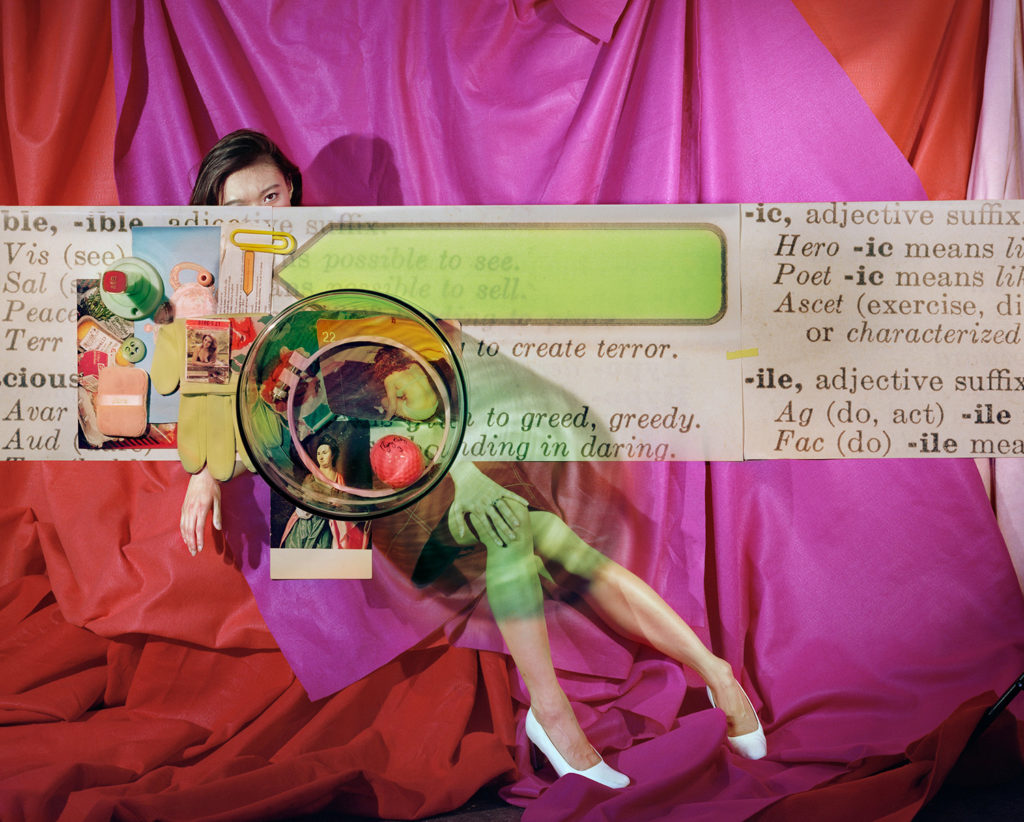
Tracy (Possible to See, Possible to Sell), 2017. Dye sublimation print on aluminum 76.2 x 96.5 (cm), 30.0 x 38.0 (inch). Edition of 3 + 2 AP
MIR: The anxiety for the artist to make something new is what I feel your work slams up to the edge of and then slowly crawls back away from. Sometimes you do this by inserting yourself also into the frame, or including models and bodies, and that feels like an entryway to talking about a specific person or idea, rather than wading in this constant image exhaustion. [Sara: yeah!]
I’m wondering, and I just came across this, that Kodak’s first advertising campaign was ‘You press the button, we do the rest’ — as if putting aside the human so this new technology, the camera, would be the only facilitator or narrator of our newly contrived worldview.
Do you think the insertion of yourself in the frame is a disruption of the technology of picture making?
SC: Yeah, one of the things that I’m endlessly interested in talking about is the ways that technology can exist separate from us. Or, the machine that just records or goes on a neutral program. It’s becoming more talked about how technologies aren’t neutral at all, they’re completely embedded in the biases and misogyny and racism of the people who made them.
One of the things I’m interested in doing is misusing technologies in a way that shows that they are not neutral. Technologies and machines and Kodak cameras are all a part of the same sort of idea of these set systems that we have to live within, and that we think are just supporting us but in fact we are supporting them; the same way that Amazon and Facebook live on the surplus value that we create through our actions and they sell our actions to advertisers and that’s how they actually all fund themselves. They need us, but we think we need them. People don’t think this anymore, but for most of the existence of these companies they did.
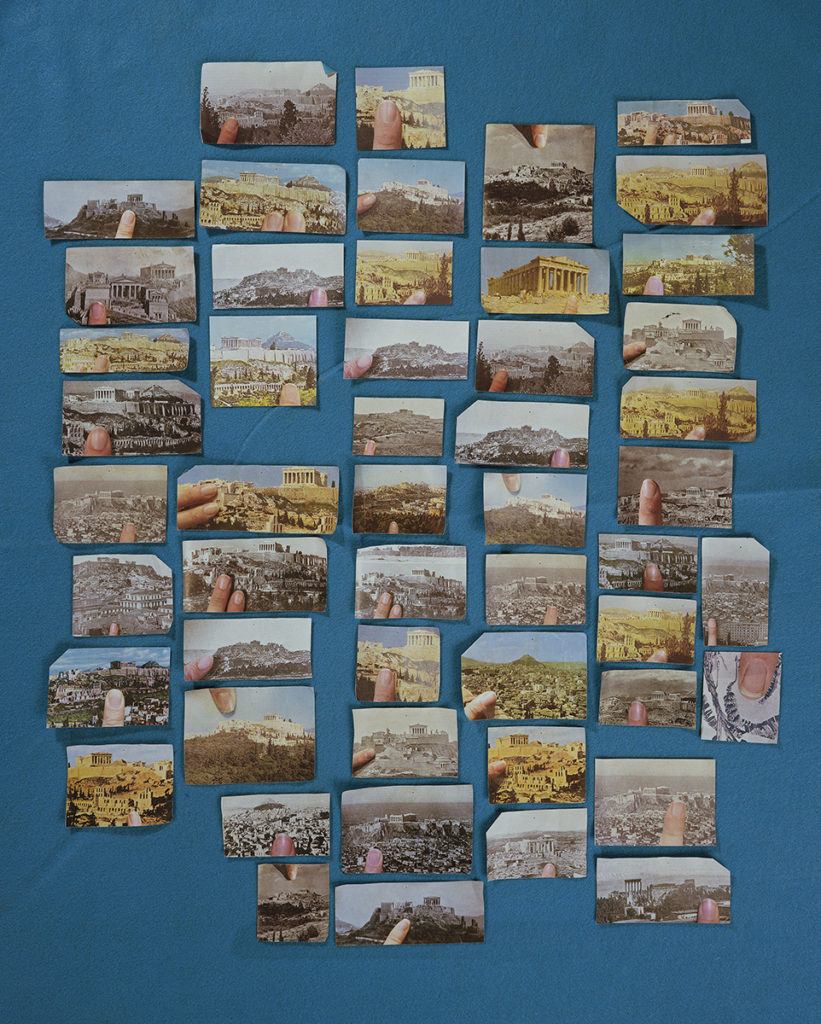
Encyclopedia Grid (Acropolis), 2014. Chromogenic print mounted to Plexiglas, 40 × 32 in. (101.60 × 81.28 cm.,) . Edition of 3 with 2 AP
MIR: I’m interested in the catalogue of different gestures you’ve included throughout your work. In earlier work like Encyclopedia Grid (Acropolis) (2014) your fingers are pointing at monuments from varying directions, and in more recent video work like
Scroll I (2020), we see you touching back at the screen. What about these gestures also relate to the idea about misusing these subsuming technologies?
SC: Yeah, definitely. I was thinking about how easily habits are formed and how our intuition gives way to formed habits, like swiping or scrolling, or things that weren’t really in our lexicon of motions before. You actually forget when you do those things and they just come as second nature, and I think like I’m doing the same motion, but aimed at the viewer instead of the phone — I’m changing it somehow. I’m trying to remind everyone that you did learn a new set of things and you did internalize a set of new values and ways of being in the world when you started using a smartphone or Facebook, or when you started liking things on Instagram. It’s really easy in the huge mess of ideas and images and content to forget where these gestures came from.
Facebook and Twitter are going to have such a huge impact on our political future and our real world, and these things are made from a base point of technological Silicon Valley-bro utopianism. Along the way all the leaders of those companies gave up on those values in order to monetize what they had started and they didn’t really think how these technologies get misused and would affect actual people, because they just couldn’t know. Every technology is like that — they end up being used in ways that aren’t meant to be and they end up wreaking havoc in ways we didn’t expect them to. I think we’re in such a rat race in capitalism that people are also just looking for ease of utility and anything makes their lives faster and easier — you can’t blame anyone for that! We become cogs in the machine of what these technologies want us to do when we just accept what they give us!
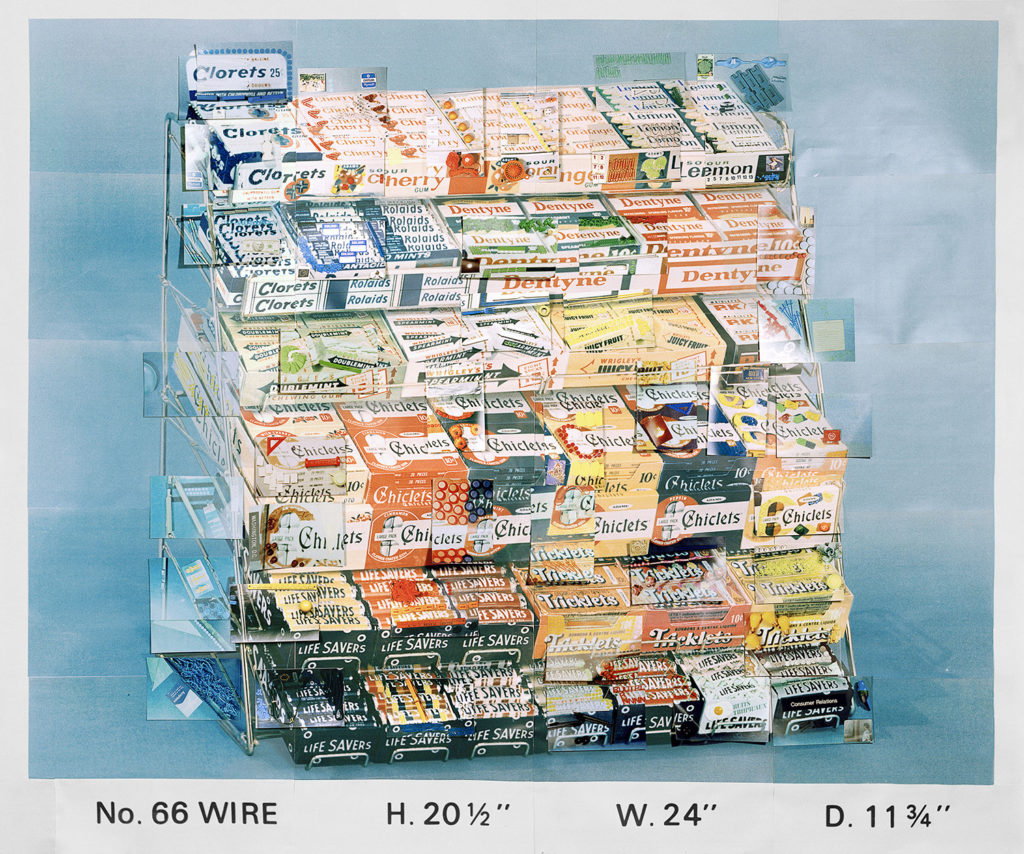
Display Stand No. 66 WIRE H. 20 1/2″ W. 24″ D. 11 3/4, 2014 Chromogenic print mounted on Plexiglas, 30 x 36 in. (76.2 x 91.4 cm.,) . Edition of 3 with 2 AP
MIR: I feel like your form of your narration is a very cool, sucker-punch type of feminist tool [Sara: laughs]. Along with the development of your voicework, I also think that your use of tape, binder clips, post-its, and bits of annotations of text, too, all speak to an earlier form of narration. How did you come to those and what’s the newest trajectory of narration that you’re using?
SC: Hmm, I’m trying to speak through proxies, through animations or pictures that aren’t me because I want to see whether certain things I say might be more digestible to certain people… if I’m not saying them. I want to experiment with who gets listened to and who gets taken seriously, and which voices rise to the top. That’s part of the content of Red Film, but also what I’m working on now, too.
So, I guess the next way I’m going to try to speak is through proxies, but I’m not exactly sure what form that’s going to take. And I’m always trying to find ways to incorporate writing like the post-its or writing directly onto photos, but that’s really hard because as soon as you put a piece of text in a photograph it becomes so loaded. You can say something off-hand or casually in a video and then as soon as it’s written down, it feels like you’re yelling it at somebody or you’re forcing them to listen. I’m also trying to figure out what I’m trying to say in that voice and what I’m trying to say in the more thrown-away voice, and the voice that doesn’t even look like me or sound like me. That’s a good question because I’m kind of in the middle of being confused about that right now, but I’m trying to think about new ways to add the voice into the work.
MIR: What projects do you have on the horizon? I believe you have a book coming out with Aperture, is that right? I’m excited to see another publication of yours after Kitsch Encyclopedia!
SC: Yes! I am making a book, most likely called Glass Life, with Aperture, that will come out in the spring. It will bring together many of the texts and references that went into my three films, Soft Film (2016), Rose Gold (2017) and Red Film (2018) in an indexical style book similar to Kitsch Encyclopedia (2014). I am also doing an exhibition at the Remai Modern in Saskatoon opening January 30. This is a very cool museum in Canada where I am making a big video installation. I am also doing a show at Foxy Production in New York in the spring. So a lot is coming up!
MIR: Thank you, Sara!
____________________________________
Stay connected with In the In-Between
_____________________________
Submit your work










